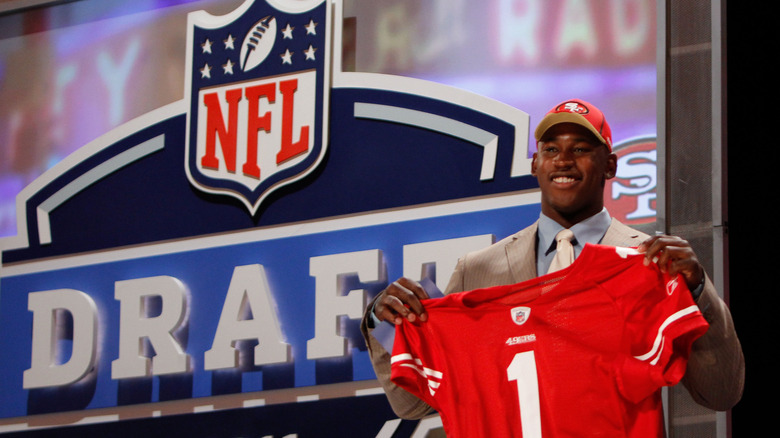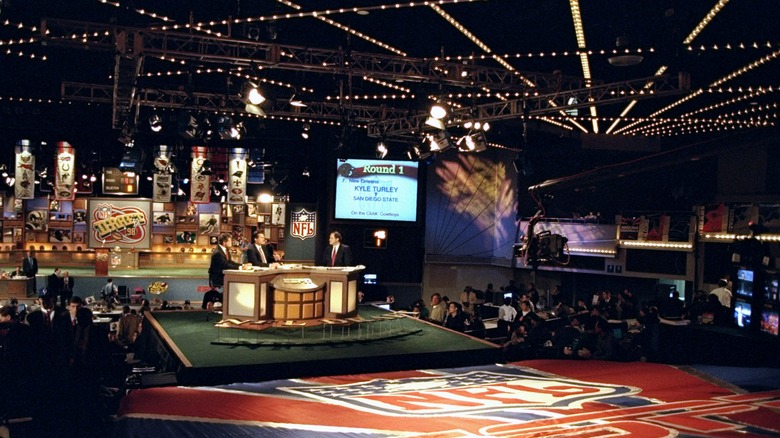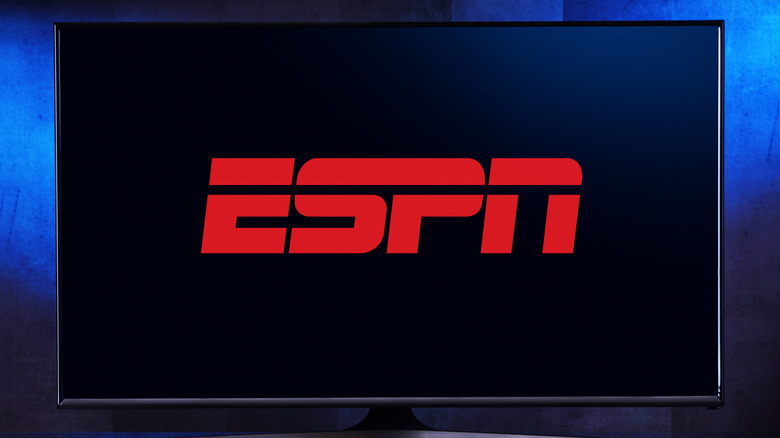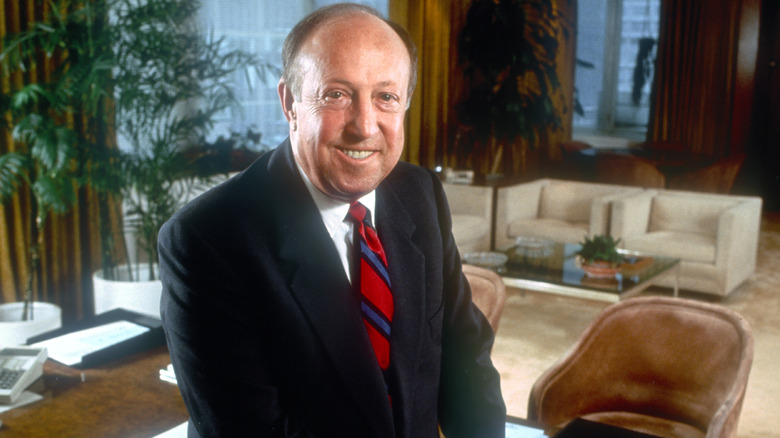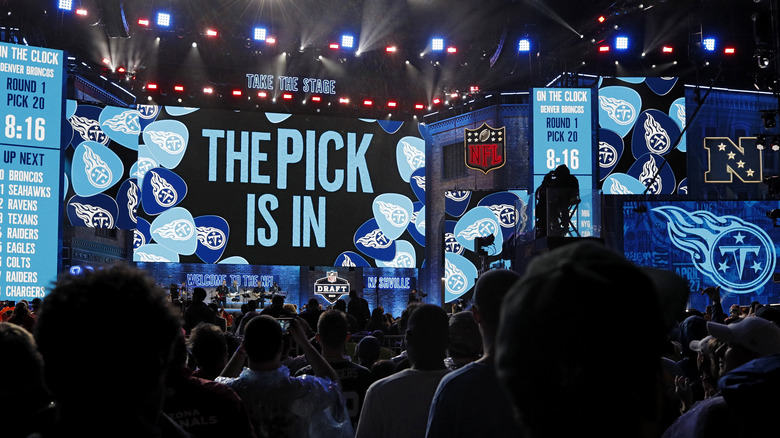When Was The First Televised NFL Draft?
The NFL draft is one of the best ways for fans to whet their football appetites during the painfully-long offseason. It's a magical time when even those who cheer for the most bumbling, hapless teams have a little nugget of hope in the form of seeing their team perched atop the draft board. From there, the entire fanbase's hopes for the foreseeable future are placed squarely on the shoulders of a player in their early 20s, and if things aren't going swimmingly in a timely enough manner when they finally get on the field, that draft pick will certainly hear a chorus of fans calling from the stands for them to be traded.
The NFL draft has become a massive event. Look no further than Nashville's experience in 2019. According to Sports Illustrated, Music City's turn hosting the NFL's marquee off-season event drew a jaw-dropping 600,000 people over three days, and in the process ruined an untold number of bachelorette parties. The television audience numbers were also astronomical that year, with nearly 48 million people tuning in.
Television is what has turned the NFL draft into the hugely-anticipated event that it is today, and it all goes back several decades to when ESPN brought up the idea of televising the draft for the first time.
ESPN came up with the idea of televising the draft
On paper — and depending on who you ask, maybe even in practice too — any league's draft is kind of boring. Sure, the moment of tension before a franchise-altering player hears their name and hops on stage to glad-hand with team brass and get a free hat is exciting. But between those few moments are stretches of sitting around while general managers make phone calls and experts pontificate over whether a recently-selected wide receiver's slightly sub-par 40-yard dash time means they won't be able to cut it at the professional level.
That's probably why the NFL's leadership was a little surprised when ESPN phoned them up and presented the idea of televising the 1980 draft, or as it was so dully known at the time, according to Sports Illustrated, their annual player selection meeting. It was an unusual proposition given it wasn't the type of event that most would consider being built for television. Nonetheless, the league was intrigued.
ESPN was still an up-and-coming network at the time
ESPN — which stands for Entertainment and Sports Programming Network (a fun bit of trivia to hurl at your friends) — was far from the sports broadcasting juggernaut that it is today. According to ESPN Press Room, the network was still in its first year of operation when they brought up the idea of broadcasting the NFL Draft, having first launched in September 1979.
The going wasn't always easy for the young network. Early programming featured some fringe sports (at least to U.S. viewers) like Australian Rules Football, but the network did manage to air some games in the early rounds of the NCAA Men's Basketball Tournament (via Sports Illustrated). The network needed to flesh out its programming schedule, and doing that required some creativity, especially on the part of then-network president Chet Simmons who thought that the NFL draft could be just the thing to get more eyes on ESPN. Of course, to do that he needed the National Football League's approval.
NFL owners were unsure of the idea
Before it was a televised event with huge production values, the NFL Draft was a much more low-key affair that was typically held in hotel conference rooms (via NFL Operations). NFL Commissioner Pete Rozelle brought ESPN's idea up to NFL team owners, and all 28 of them promptly voted down the idea of televising the annual player selection meeting.
According to Sports Illustrated, one of the biggest parts of Rozelle's legacy as the league's commissioner is the series of innovations he made when it came to expanding the NFL's reach on television. Rozelle led the charge in signing huge television deals adding an extra day to the NFL television schedule to weekdays with the introduction of "Monday Night Football."
Rozelle must have smelled another TV hit for the NFL because he completely ignored the owners' vote. "Pete walked out of that room and turned to me and said, 'Call Chet Simmons and tell him that he's gonna do the draft as a news event. And we can't stop him from covering it,'" recalled Jim Steeg, who was NFL's Vice President of special events back in 1980.
ESPN broadcasted a new marquee event in 1980
Anyone who has watched the NFL Draft knows that while the draft is now a three-day event, the talking heads on ESPN can yammer about it endlessly. This thirst for getting as much to talk about when it comes to the NFL Draft goes back to the original broadcast because as soon as they were given the thumbs up from Commissioner Rozelle, the folks at ESPN started digging up as much as they could about players expected to come off the board early in the draft and what each team's needs were (via Sports Illustrated).
The first televised NFL Draft aired on April 29, 1980, and the network had done its due diligence to make sure they put on the best broadcast they could, even putting together highlight packages for players expected to be selected early in the draft. As the years progressed, the television aspect of the draft became bigger. By the 1990s, crews were interviewing prospects, with agents even battling to get their clients some air time.
For many years, the NFL Draft was typically held in New York City, often at Radio City Music Hall (via the Pro Football Hall of Fame). In the 2010s, the league started moving the draft to different host cities, each selected in a bidding process similar to the one used for the Super Bowl. The NFL Draft was officially a major event in the eyes of the league, fans, and broadcasters alike, and it can all be traced back to when ESPN pitched the idea of bringing it to television in 1980.
